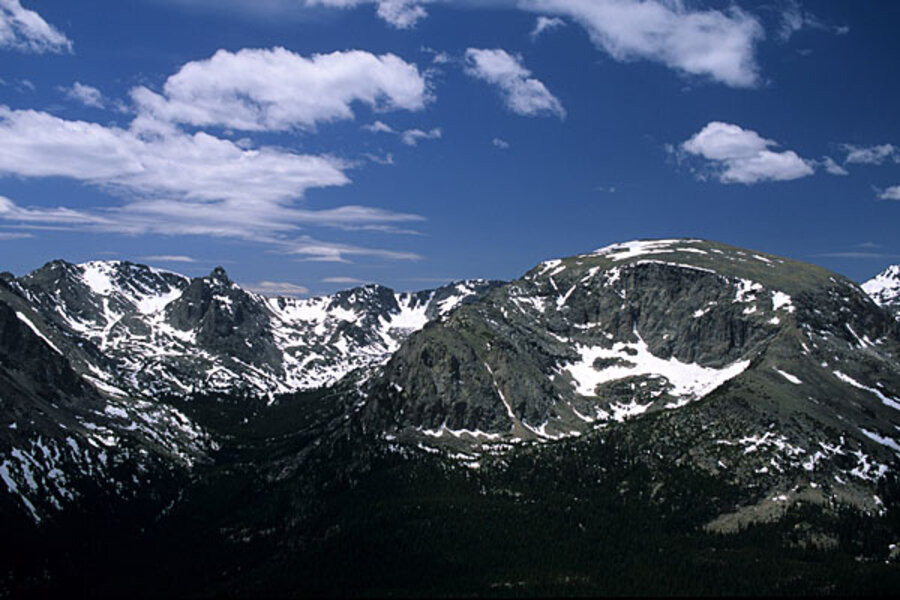The new water wars? Study shows broad decline in Rockies snowpack.
Loading...
A blend of natural climate swings and global warming appears to be driving a long-term decline in snowpack along the Rocky Mountains rarely seen in the past 800 years.
In the process, and perhaps more important for the future, the dominant driver behind available snowpack along the continental spine appears to be shifting from precipitation to temperature, according to a study published Friday in the journal Science.
If this shift holds, the study's team adds, it could represent a change that would accelerate the loss of the West's natural freshwater reservoirs – if long-term average temperatures continue to rise with increasing levels of industrial greenhouse gases, as most climate scientists are convinced they will.
"I was shocked" when this result emerged, says Gregory Pederson, a hydrologist at the US Geological Survey's Northern Rocky Mountain Science Center in Bozeman, Mont., who led the effort.
Similar shifts show up in the 1300s and 1400s, when the Rockies experienced warming periods, he says, but temperatures then weren't nearly as warm as today. Nor was the shift as strong.
Many studies have documented the West's declining snowpack. And at least as early as 2005, some researchers began to notice the potential regime shift that Dr. Pederson and his colleagues see, notes Klaus Wolter, a researcher at the National Oceanic and Atmospheric Administration's Earth System Research Laboratory in Boulder, Colo.
Still, this is the first time scientists have attempted to reconstruct the history of snowpack throughout the length of the Rockies in a systematic way and "for a very nice, long period," he says.
The new study, conducted by a team of scientists in the United States and Canada, drew on tree-ring records that the team related to snowpack. The scientists focused on three broad regions in the Rockies that host the headwaters for major Western river systems, such as the Columbia, Missouri, and Colorado Rivers.
While the shrinking snowpack in the 20th and early 21st centuries is not unprecedented from a climate-history standpoint, at no time in the past 800 years have so many people relied so heavily on these winter snows for their fresh water. The rivers and the drainage basins that feed them provide as much as 80 percent of the water used for irrigation, power generation, and other purposes by some 70 million people, according to the study.
Of particular interest is the shift in the snowpacks' response to natural variations in climate over the tropical and northern Pacific, which occur on time scales of a few years to a few decades.
Typically, gains and losses of mountain snowpack seesaw between the northern and southern Rockies with these natural swings in Pacific climate patterns, Pederson explains.
This feature stands out in the team's data throughout the past millennium, with a couple of notable exceptions around 1350 and the early 1400s, when warmer average temperatures reduced snowpack up and down the length of the Rockies at the same time.
The seesaw still occurs to some extent. But since the 1980s, snowpacks again have been declining along the entire length of North America's geological spine, regardless of the state of these natural climate swings.
In the northern Rockies, which host the headwaters of the Columbia River, the shift began even earlier. Snowpack in this region is more sensitive to temperatures changes than snowpack farther south because the relatively low elevations mean winters and springs are somewhat warmer to start with, Pederson explains.
This latest work represents further evidence that the region's largest reservoir of fresh water – snowpack – is diminishing, says Juliet Christian-Smith, a senior research associate at the Pacific Institute, a water-resources policy research group in Oakland, Calif.
"We often think of surface storage in reservoirs as our main source of water supplies," she says. But most of the region's surface-water storage is in mountain snowpack.
"We're getting to a point where our short-term response strategies" for individual droughts "aren't going to work over the long term" in dealing with the looming shortages the shrinking snowpack will bring, she says.





